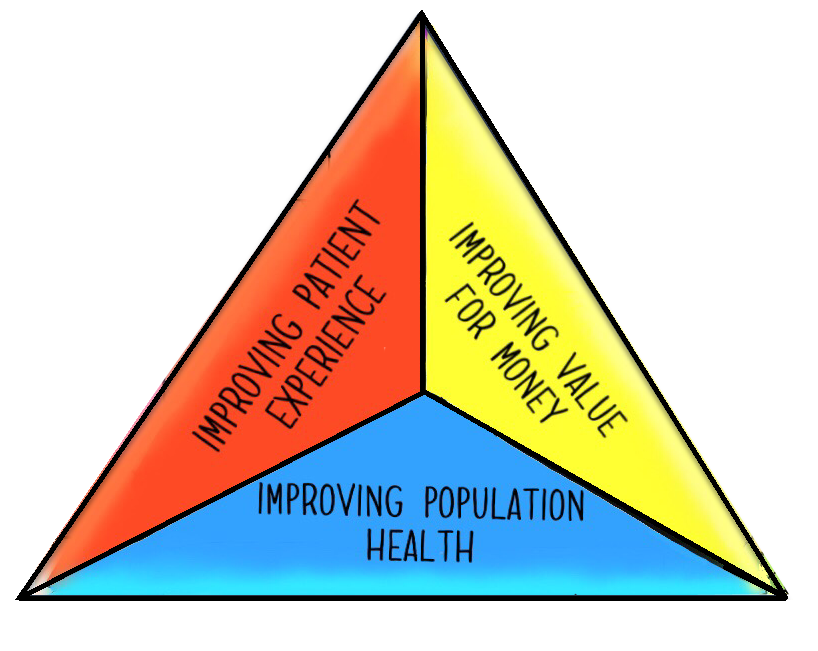
Triple Aim Project Teams Come Together to Share Learning Around Measurement
25th June 2021
By Francisco Frasquilho, Senior Improvement Advisor, ELFT QI
On the 16th of June seven teams attended the Triple Aim learning session, bringing together staff, service users and partners from all around the Trust, and beyond, to progress their projects and share learning. Triple Aim is the Trust’s approach to simultaneously improve health outcomes, experiences of care, and value, for an identified population (figure 1). The Triple Aim learning sessions, which were postponed until recently due to the pandemic, are designed to support teams working with a wide range of populations and issues.
Figure one: Triple Aim approach triangle
Teams who joined the learning session included projects seeking to improve health for a variety of populations including:
- People who are homeless within Tower Hamlets
- Care home residents across 5 care homes in Tower Hamlets
- Asian men over the age of 40 living in Bedford
- Veterans living within the Trust area
- People who attend crisis services in Newham
The learning session focused on helping teams develop their measurement plans. “Measuring the Triple Aim” is a challenging yet essential part of Triple Aim work. Traditionally in QI work, teams develop a simple “family of measures” however Triple Aim requires a three-pronged approach to measurement to ensure understanding of progress around health outcomes, experience of care and value.
At the learning session, teams had an opportunity to share stories of their work and to receive dedicated coaching by Improvement Advisors. The Tower Hamlets Care Home Liaison team presented their project and shared their progress in understanding the needs of the care home population in Tower Hamlets. They highlighted how important is to listen to the needs of their population, and how measurement had informed their decision making. To help track the impact of their population work, the team used a measurement plan for their data collection approach (figure 2).
Figure 2: Measurement plan used by Tower Hamlets Liaison Team to develop their measures
They also developed charts to demonstrate the variation in key measures over time, to identify which factors can lead to improvement in the populations Triple Aim (figure 2), charts showing baselines measures around wellbeing for residents and number of ambulance call outs as measures related to Healthcare outcomes and Value, respectively (figure 3/4).
Figure 3: Baseline Control Chart of sequential Dementia Care Mapping tool assessments outcomes: Well and Ill being score for sequential resident assessments (Higher scores are better in terms of rated wellbeing)
 Figure 4: Baseline Control chart for Number of Ambulance Call outs by month as a measure of health outcomes potential value/cost (less is better)
Figure 4: Baseline Control chart for Number of Ambulance Call outs by month as a measure of health outcomes potential value/cost (less is better)
All the Triple Aim teams had the opportunity to explore and work on their own measurement plans. The teams were challenged to come up with a set of measures they can put into use with least one individual from their key population in the next two days with at. Using the template below (Figure 5) teams had dedicated coaching support breakouts using some ‘key tips’ to support their development and use of measurement.
Figure 5: Triple Aim Measurement template to guide discussion of triple aim measures, definition of the measure, and data collection
Key Tips for measurement and data collection in the Triple Aim:
- What data do you have now that is good enough to help you know if the changes are leading to improvement?
- Are the measures sensitive to change?
- Do they make sense to those organisations and populations involved?
- Are they actionable, practical?
- Measure just enough to know if the changes you are making are leading to improvement
- No measure is perfect, you may have to change it once the work starts and you learn more
One further key tip developed from this session, is that it is never too early to think about how to measure aspects of the Triple Aim!
Breakout room feedback showed that teams developed at least one, and in some cases two and three measures for each area of the Triple Aim. It was clear that teams and service user already brought their own experiences of the population with them. The measurement template helped turn this into a useful measurement process to support measuring the pulse of the Triple Aim in their chosen populations.
Teams equipped with a measurement plan ensure they will have a much better chance to identify variation in the needs and outcomes of their chosen population.
Most Read Stories
-
Why is Quality Control important?
18th July 2018

-
An Illustrated Guide to Quality Improvement
20th May 2019

-
2016 QI Conference Poster Presentations
22nd March 2016
-
Recognising Racism: Using QI to Help Take Action
21st January 2021

-
Using data enabled us to understand our problem
31st March 2023

-
QI Essentials: What does a Chief Quality Officer do?
18th March 2019


Follow QI on social media
To keep up to date on the latest concerning QI at ELFT, follow us on our socials.






